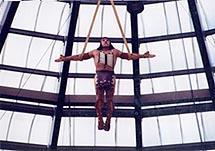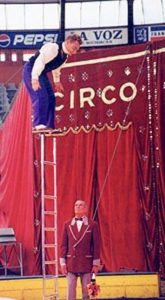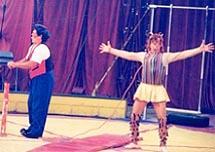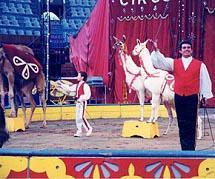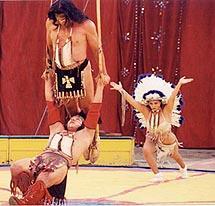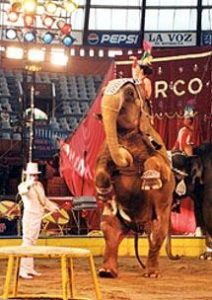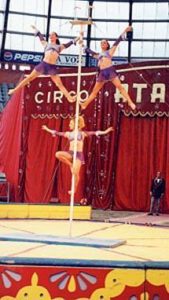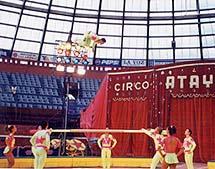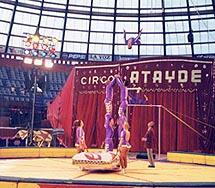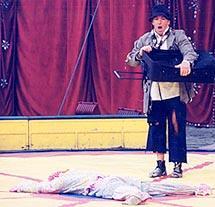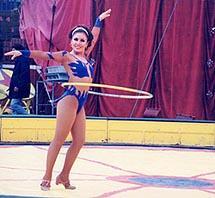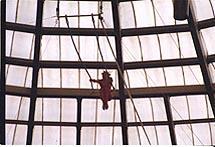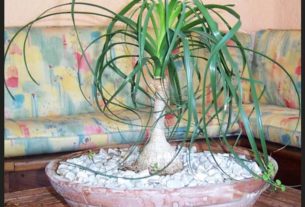I recently had the pleasure of seeing a living legend, the Atayde Hermanos circus. Founded by Aurelio Atayde Guizar and his brothers in Zacatecas on August 26, 1888, it is the longest living circus in Mexico. Señor Atayde Guisar ran away from his home in Saltillo as a child to find work in a traveling circus, then returned years later to round up his brothers. In 1909, the circus’ tent was the site of a political meeting of revolutionaries, led by Francisco Madero. During those early years, its performances were attended by Francisco “Pancho” Villa, Alvaro Obregon, Venustiano Carranza and Elias Calles.
Over its 114 years of entertaining humanity, Atayde Hermanos has performed in Central and South America as well as Mexico. In 1936, three Atayde siblings, Aurelio, Patricia and Andres Atayde Arteche toured the European continent and entered the Guinness Book of Records by virtue of a feat never before achieved in a gymnastic bars act.
Since 1946, Atayde has been based in Mexico City. Its first performances there were under a tent erected in the street. Later, the circus presented its spectacular show in the “Arena Mexico”. The most recent performances have been in the “Palacio de los Deportes”. In October of 1998, they entertained more than thirty thousand spectators during a run of nine days in the Sports Arena in Los Angeles, California.
Atayde Hermanos Circus features twenty-three artists hailing from Cuba, Mexico, Peru and the U.S.A. There are a total of 14 acts. When they perform in Morelia, they use the Palacio del Arte, a circular structure with built-in bleacher seating also used for events such as bull-fights and concerts. It has a domed roof constructed of twenty three massive curved metal beams that surge upward and meet at the apex. The spaces between the beams are filled with translucent panels.
While discussing interviews with the Atayde Hermanos Circus public relations representative, I told him I wanted to speak with most of the artists. I had seen the whole show twice the previous day and taken photographs. I specifically requested that at least two of the Cuban male acrobats and two of the women of the awesome all Cuban “Trouppe Febles” come to speak with me.
The troupe’s two female artists came to talk to me and were friendly and cooperative. One of the males approached me and said cursorily, “I hear you’re handing out free photos”? I smiled and concurred that I was but that I also wanted to interview some of the performers. As I spoke, his eyes searched the table next to me for the pictures. I asked half in jest if the photos of his troupe were a condition of the interview. He shrugged his shoulders as if to say, “Well, sort of”. I handed him the pictures and he scanned them almost hungrily, as if this were a rare pleasure for him. One photo showed the troupe after they had sprung someone from a standing position on a long, flexible bar high into the air. The person in the air was in the middle of a series of somersaults a good thirty feet above the bar. He pointed to it with childlike glee and said, “That’s me”.
He then began to answer my questions, talking into my micro-cassette recorder, in what for my ears was the hardest-to-understand Spanish I had ever heard. My mind wandered a bit and I thought that maybe the Cubans preferred not to talk to an American for political reasons.
The next night while awaiting the end of the intermission, I spotted another person from the Cuban troupe. I caught his eye. He stood his ground until I approached him. I told him I had some photos for him. His eyes, too, hungrily scanned the pictures I pulled from an envelope, his gaze coldly avoiding mine. I told him they were his to keep and congratulated him on his and the troupe’s outstanding work, offering my hand.. His face lit up with a friendly smile, almost with a look of surprise. He shook my hand warmly and thanked me.
This masterful group of Cuban acrobats of the “Trouppe Febles” includes two females and six males. Every one of them is a graduate of the four year National Cuban School of Circus Performance in Havana, Cuba, and are all between the ages of twenty to twenty three. Each one is a specimen of physical fitness. The men have muscular torsos and broad necks. The women have picture perfect figures. At around the age of fourteen, candidates for the school have to pass an academic and physical test to be admitted.
I asked every one of the Cuban performers in the circus, including the “Trouppe Febles”, the “Duo Sagitario” and the “Trio Paradigma” if they liked Mexican food. Every one of them laughed and said, “yes, if it doesn’t have chiles”.
When an act billed as the Muneca Viviente was announced, I heard some mumbling from the audience behind me. I turned in my seat and saw a man dressed as a hobo standing in the spotlight, shoulders drooping and sadness exuding from his face. The background music was melancholic. He had an old paper bag, from which he pulled one rag after another, each time looking disappointed as if he were expecting something better. He suddenly spotted a suitcase sitting in the middle of the ring. He ambled over to it, looking more hopeful. He opened it and began pulling out useless items. His facial expression darkened with dismay. Then, he lifted out what looked like a rag-doll. He put it down on the ground and started to move it about alternatingly folding it, bending it and swinging it in all directions. Although I had been told previously that this act featured an apparent rag-doll that turns out to be a woman, I still thought at this point that the rag-doll was inanimate. It was a tribute to the masterful work of an extremely petite, astoundingly flexible Cuban woman who soon revealed herself, making the hobo happy because his lonliness was ended. They kissed and the act ended. The male member of this pair, known as the “Duo Sagitario”, is also Cuban.
Ottavio Canestrelli is one of the circus’ three clowns. He works solo. His face alternates between joy and sadness, reminiscent of some of the clowns in Fellini’s movies. His acts include some clownish pratfalls, a small amount of gymnastics, and a stunt in which he walks up the rungs of a vertical aluminum ladder which is not supported or restrained. He gets to the very top. Balancing there, he does some juggling.
An American, born and raised in California, his father owned and performed in a circus in the south of Italy before the Second World War. After World War Two, Ottavio’s father came to the U.S. and performed in Ringling Brothers Barnum and Bailey Circus. He has a family background heavily entrenched in circus work.. As a child, he was taught many of the circus skills by family members and circus performing friends. I asked if he spoke any Italian. He chuckled. “Only the insults my father used to throw at me”. His English doesn’t help him much performing in Mexico in a Mexican circus. He speaks very little Spanish.
Years ago, he thought he would break out of the mold of circus performers. He got married and started college. He took two years of training as an actor. He came to the realization that not only did he dislike being a college student but that married life didn’t suit him. College was difficult for him because he is dyslectic. He was divorced from his wife and decided he was meant for the circus after all. He has a seven year old daughter in the U.S.
Probably, my favorite act of the Atayde Hermanos Circus was the Guerreros Aereos or “Warriors of the Air”. It is a dramatic, stirring rendition of a Native American ritual in which two young men dressed in authentic Native American garb soar over the circus ring with their arms wrapped in leather straps attached near the top of the dome. They do this with admirable smoothness and muscular control to a backdrop of Native American music. Accompanying them is a woman also dressed in a Native American outfit including a feathered war bonnet. She dances to the lilting music with utter grace, seemingly performing prayers to the spirits.
The young woman, a delightful and charming person, speaks flawless Spanish and purrs English like a “Valley girl”. Her name is Roxanne Onofre. Her face, magnetically attractive, seemed to change its appearance during her dance, her appearance for the finale, and when I spoke to her in person. Her mother is descended from the Apaches and the Navajos in the U.S. Her father is Mexican but she was born in the U.S. and is American. Her uncle owns and runs a circus in northern Mexico. She has worked for the Disney Organization in California.
She met the two young men of the act, Douglas and Oliver Ramos, in Oklahoma. She refers to them as her brothers because they are such close friends. The men are Mexican, although they lived in the States since the age of three and have called Las Vegas their home for eight years. They come from four generations of circus people.
They originally developed the act in Oklahoma because they both had a love of the Native American culture. They were required to get permission from the chiefs of three Native American tribes to wear the authentic garb they use in their act, by virtue of U.S. laws passed to protect Native American culture. They were also initiated into a Native American tribe. The initiation consisted in participating in a variety of tribal rituals, then having their chests pierced by bones. They were left to hang above the ground by these bones. They were then giiven whistles made out of the bones of an eagle with which they summoned the godly spirit of the eagle asking it to relieve their pain. To pass the initiation, they either had to wait until the bones broke or until they pulled out of their flesh. They passed by the latter.
The animal act features trainer Jim Garner, assisted by his son of thirteen, two camels, two llamas, two guanacos, two English ponies, and two Arabian camels. Although not as exciting as a lion or tiger act, it is well done and the animals appear well cared for. Jim Garner, by the way, is no relation to “Maverick”. His father is American, his mother Mexican, and although born in Oklahoma, he has lived in Mexico most of his life. He states he is all in favor of government regulation of the ownership of “exotic animals” which is making it increasingly difficult for circuses the world over to have such creatures. Presently, in Mexico, circuses can only have lions and tigers if they rent them for a year at a time from approved caretakers.
Atayde Hermanos is rounded out by Dayana, a Peruvian woman who is the best hula-hoop artist I’ve ever seen. Clarisleydi is a beautiful young Cuban woman who does a solo high trapeze act with finesse. The Trio Paradigma is a group of three Cuban women that do a gymnastic routine on a vertical pole. The two clowns, Chancleta and Lentejita, from Peru, lend expert comic relief. Chancleta is the father of Dayana. The last act before the finale is the “Dance of the African Elephants” in which several tremendous elephants cavort around the ring, carrying some of the female performers on their necks. They are well-trained. One walks on his two hind legs.
To say that Atayde Hermanos Circus is the best Mexican circus I have yet seen may be damning it with faint praise. It is smaller than many internationally known circuses but the quality of its performances is world class. Atayde Hermanos achieves this without elaborate special effects so common among world renown circuses of today.

